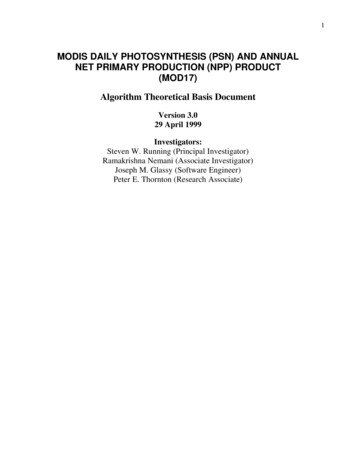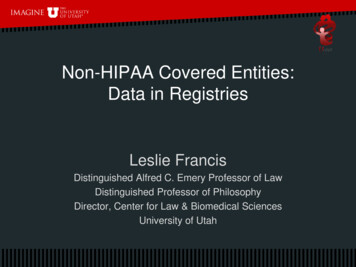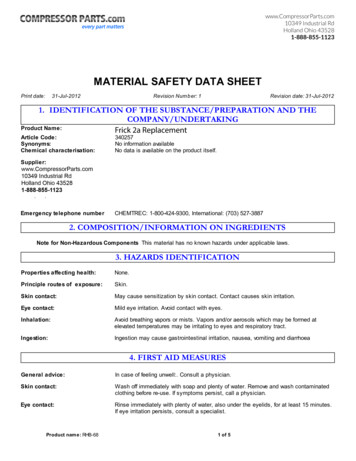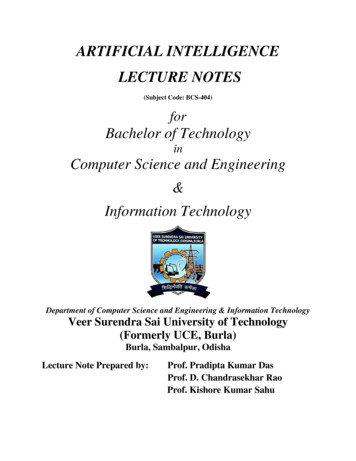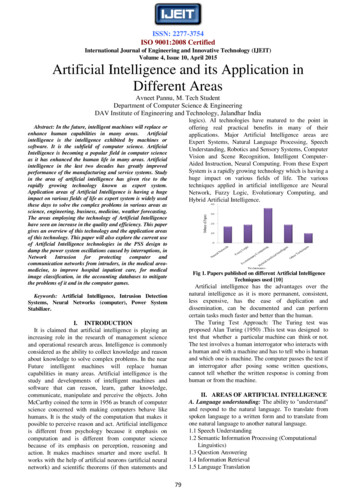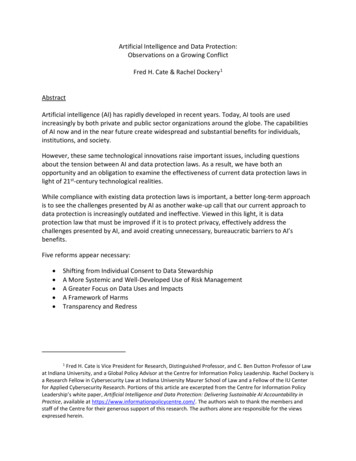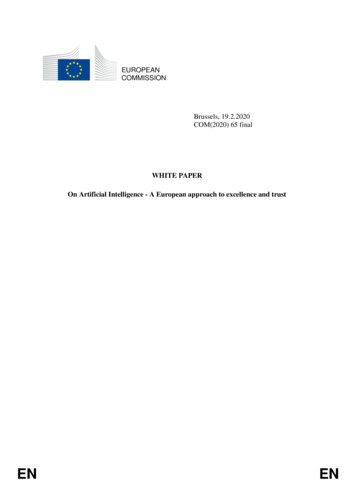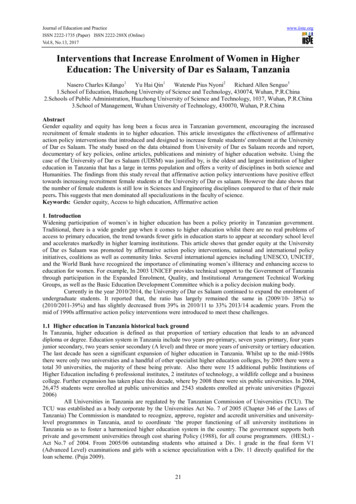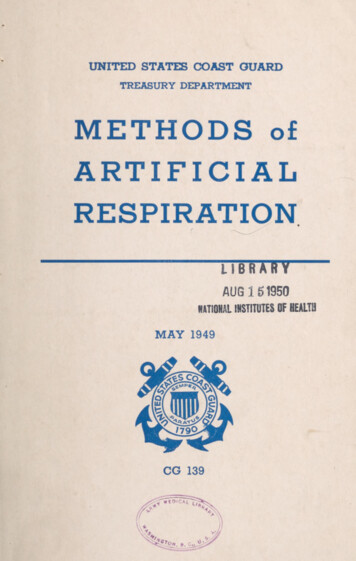
Transcription
UNITED STATES COAST GUARDTREASURY DEPARTMENTMETHODS ofARTIFICIALRESPIRATIONMAY 1949CG 139
UNITED STATES COAST GUARDTREASURY DEPARTMENTMethods ofArtificial RespirationREV. MAY 1949CG 139UNITED STATESGOVERNMENT PRINTING OFFICEWASHINGTONForgale by the Superintendent of Documents,Washington 25, D. C.-:1949U. S. GovernmentPrice 10 centsPrintingOffice
6 May1949.INTRODUCTIONThis publication cancels and supersedes the pamphlet ‘‘Methods ofArtificial Respiration” (CG-139) dated 17 June 1948 and all previouseditions thereof.The two manual methods of artificial respiration approved forCoast Guard use are the Schaefer Prone Pressure Method and the EveMethod, either of which may be used in conjunction with the application of oxygen.All Coast Guard personnel shall be trained and become proficient inthe methods of artificial respiration in accordance with the proceduresand rules set forth in this publication.Merlin O'NeillRear Admiral U. S. Coast Guard,Acting CommandantDistribution (SDL No. 38)A a b c (5 ea) d e f i (3 ea) ; remainder (1 ea).B: g (20) ; c (14 ea) ; 1 (10) f (9) ;e h i (5 ea) ; j (3)C; a d (3 ea) remainder (1 ea).D; All (1 ea).E: None.:;;;d k (2 ea) ;b m (1 ea).;Additional copies for training purposes sent all units under separatecover.
TABLE OF CONTENTSPageAsphyxiaSymptoms of AsphyxiaTreatment of AsphyxiaSchaefer Prone Pressure MethodEve MethodThe InhalatorGeneral Rides and InformationShockTreatment of Shock11124881010
METHODS OF ARTIFICIAL RESPIRATIONASPHYXIAAsphyxia is a condition in which breathing lias stopped. It may bethe result of either abnormal physiological or physical causes.The physiological causes of asphyxia may include lack of stimulationof the respiratory center in the brain, paralysis of the respiratorycenter, and the inability of the blood to absorb oxygen from the lungsor to effect the normal exchange of gases in the body tissues.When it is due to physical causes, it may he spoken of as suffocation.In asphyxia resulting from physical causes the lungs are deprived ofair because of stoppage of the air passages mechanically. Such causesmay include water in the air passages, as in drowning; foreign bodyin the air passages; tumor in the air passages; swelling of the mucousmembrane in the nose and throat following inhalation of live steamor an irritating gas; constriction around the neck compressing thewindpipe; and the lack of oxygen from any cause. The most frequentcauses of stopping of breathing are drowning, electrical shock, and gaspoisoning. Asphyxia may be present also in victims of shock or collapse, of extreme exposure to heat or cold, and chemical poisoning.SYMPTOMS OF ASPHYXIAThe symptoms by which the necessity for artificial respiration maybe recognized are: Cyanosis (blueness of the skin and membrane),suspension of respiration, or shallow breathing in some cases ofpoisoning.TREATMENT OF ASPHYXIAThe first thing to do in treatment is to remove the cause of the asphyxia or to remove the patient from the cause. Then administerartificial respiration. Later treat as for shock. In some cases artificial respiration can be administered while the patient is being removedfrom the cause to more suitable surroundings. The treatment for shockcan often be started while artificial respiration is being administered.The patient’s mouth should be cleared of any obstruction, such aschewing gum, tobacco, false teeth, or mucous, so that there is no interference with the entrance into and escape of air from the lungs.Artificialrespiration should be started immediately. Every momentof delay is serious. It should be continued for at least 4 hours without1
2METHODSOF ARTIFICIAL RESPIRATIONinterruption until normal breathing is established or until the patientis pronounced dead by a medical officer.Not infrequently the patient, after a temporary recovery of respiration, stops breathing again. The patient must be watched and ifnatural breathing stops, artificial respiration should be resumed atonce. Perform artificial respiration gently and at the proper rate.Roughness may injure the patient.Every precaution must be taken to prevent further injury to thepatient. It may be necessary to give artificial respiration over a prolonged period of time. In the methods that require the applicationof pressure, injury to the skin, ribs, and internal organs must beavoided.SCHAEFER PRONE PRESSURE METHODThe Schaefer prone pressure method can be carried on for a considerable length of time by one person and without danger to the patientif the operator does not exert undue pressure. Its principle is alternately compressing the chest and releasing the pressure, thus causingair to flow out of and into the lungs. Approximately 60 pounds pressure is probably sufficient even for a large adult. Even though a different method of artificial respiration is to be used later, the Schaefermethod should be used until conditions are such as to permit institutionof the better method.1. Lay the patient on his abdomen, one arm extended directly overhead, the other arm bent at the elbow and with the face turned sideways and resting on the hand or forearm, so that the nose and mouthare free for breathing. (See fig. I—first1 —first position.)FIG. 1
METHODS OF ARTIFICIAL RESPIRATION32. Kneel, straddling the patient’s thigh on the side toward which theface is turned, with your knees placed at such a distance from thehip bones as to permit the position shown in the figure. (See fig. 1.)Place the palms of the hands on the small of the back with thefingers resting on the ribs, the little finger just touching the lowestrib, with the thumb and fingers in a natural position and the tips ofthe fingers just out of sight. (See fig. 1.)3. With the arms held straight, swing forward slowly, so that theweight of the body is gradually brought to bear upon the patient. Theshoulder should be directly over the heel of the hand at the end ofthe forward swing. (See fig. 2—second position.) Do not bend theelbows. This operation should take about 2 seconds.FIG. 24, Now immediately swing backward so as to remove the pressurecompletely. (See fig. 3—third position.)5. After 2 seconds swing forward again. Repeat unhurriedly 12 to15 times a minute the double movement of compression and release, acomplete respiration in 4 or 5 seconds.6. As soon as artificial respiration has been started and while it isbeing continued, an assistant should loosen any tight clothing aboutthe patient’s neck, chest, or waist. The patient should be kept warm.7. When natural breathing has been restored, the patient should betreated as for shock.8. In carrying out resuscitation it may be necessary to change theoperator. This shift can easily be accomplished while counting therhythm aloud.
4METHODS OF ARTIFICIAL RESPIRATIONFIG. 3EVE METHODFigures 4-8 illustrate the shift from Schaefer to Eve, and the principal positions of the Eve Method. These illustrations also indicatehow the inhalator is used for both the Schaefer and Eve Methods.The Eve Method makes use of the weight of the abdominal organsalternately to push and pull the diaphragm up and down in the mannerof a piston and consists of rocking the patient, securely lashed to thelitter or board, over a fulcrum. This method is easy on the patient,is less tiring to the operator, and requires less skill than other methods.Its disadvantage is that it requires some apparatus, namely a litter,or board, and a fulcrum. The apparatus illustrated is specially designed for the purpose; however, apparatus may be improvised whichwill accomplish the same effect. In any case, regardless of the type ofapparatus available, the shift from Schaefer to Eve should not bemade until it is certain the apparatus is in all respects ready for properoperation.Procedure:1. The patient is laid face down on a litter or board, with armsoutstretched or at the sides, whichever is more convenient. (See fig. 4.)2. The application of the Schaefer method is resumed as quickly aspossible with the least interruption of rhythm. (See fig. 4.)3. The ankles and wrists are secured to the litter or board.fig. 4.)(See4. If an inhalator is available, it is applied in accordance with therules and instructions on page 7 and in the directions furnished withthe equipment.(See fig. 5.)
METHODS OF ARTIFICIAL RESPIRATIONFIG. 4FIG. 55
6METHODS OFARTIFICIAL RESPIRATIONFIG. 6FIG. 7
METHODS OFARTIFICIAL RESPIRATION75. The fulcrum is set up near the litter and within reach of the inhahit or hose. (See fig. 5.)6. The litter, or board, is placed on the fulcrum. (See fig. 6.)7. In resuscitating an apparently drowned person, the first headdown tilt should be maintained until no more water drains from thestomach or lungs,(See fig. 7.)8. The litter, or board, is rocked at 10 complete rocks a minute (“feetdown 10 times a minute”) with a tilt each way of 45 to 50 . (Seefigs, 7 and 8.)FIG. 89. Continue until normal breathing is restored or until the patient ispronounced dead by a medical officer.10. The patient should be kept warm.11. When artificial respiration has been started, the treatment forshock should be instituted.THE INHALATORThe inhalator provides a supply of oxygen and carbon dioxide fromwhich the lungs fill when manual artificial respiration is performed.
8METHODS OF ARTIFICIAL RESPIRATIONSince lack of oxygen is the basis for asphyxia from any cause, be itsubmersion, carbon monoxide, strangulation, electric shock, etc., theuse of oxygen in resuscitation is highly desirable. A small percentageof carbon dioxide is added to prevent the loss of this respiratory stimulant during prolonged artificial respiration.Inhalator apparatus consists of a tank of oxygen-carbon dioxidemixture, pressure reduction system, flow meter and rubber hose leading to a nasal tube. The mixture contains 95 percent oxygen and 5percent carbon dioxide by volume. It is applied as follows:(1) Manual artificial respiration is continued without interruption.(2) The throat and mouth of the patient are freed of fluid, vomitus, etc., by careful wiping to insure a free airway. This should berepeated occasionally thereafter.(3) With the oxygen-carbon dioxide tank open, a flow of two litersper minute registered on the flowmeter is permitted to pass throughthe system and out of the nasal tube. The nasal tube is then passedthrough the nostril to a distance equal to 1 inch less than the distancebetween the nostril and the ear canal. It is held in position by beingpassed backward over the head and secured at the forehead by adhesivetape.(4) The head of the patient is tilted somewhat back toward theshoulder blades, straightening the air passages and preventing thetongue from falling backward and blocking the windpipe. The flowof oxygen-carbon dioxide mixture is gently raised to 4 liters per minutewhich is continued thereafter.(5) Actual regulation of the inhalator mechanism will depend on(he type and make used. The directions with the equipment should befollowed. The above are general principles pertaining to inhalationfrom apparatus of any kind.(6) Inhalation of oxygen may be rendered entirely safe if precautions are taken against explosion. There should be no oil whatever onor near fittings, and no lighted matches, pipes, cigarettes, etc., allowedin the vicinity of the resuscitation.GENERAL RULES AND INFORMATION1. Coast Guard procedure for artificial respiration is now officiallybased on the Schaefer and Eve Methods combined with oxygen byinhalation. The Howard-Sylvester Method is no longer approved asa Coast Guard method. The general rules outlined below are set forthas a guide to determine the proper course of action under various con-
METHODS OF ARTIFICIAL RESPIRATION9ditions and to establish effective coordination with appropriate localorganizations.2. Inhalation is accomplished by means of “inhalator” apparatuswhich provides a means of supplying oxygen, or a mixture of oxygenand carbon dioxide, while inspiration and expiration is being inducedby manual (Schaefer or Eve) artificial respiration. Many CoastGuard units are now equipped with inhalators and additional unitswill be furnished the equipment as it becomes available. Whenever aCoast Guard unit is not provided with an inhalator, advantage shouldbe taken of oxygen brought to the scence of a resuscitation operationby civilian or other rescue teams.3. The mechanical resuscitator (sometimes referred to as the ‘‘pulmotor”), which is not furnished to Coast Guard units, is an apparatuswhich supplies oxygen, or a mixture of oxygen and carbon dioxide,while inspiration and expiration is being induced by the applicationof alternating pressure. Although this equipment has its place whenmanned by skilled hands, it is possible that it may operate as a hazardrather than a help if it is handled unskillfully. Most resuscitators canbe set up to operate as simple inhalators. Risks connected with the useof the pressure feature of the resuscitator can thus usually be avoidedsimply by using the resuscitator as an inhalator, in accordance withparagraph 4 (b) hereof.4. Gomparison of Methods and Rules for Their Use:(a) The Schaefer method requires no equipment and is the quickestto put into operation. It should therefore be started immediatelyupon removing a victim of submersion from the water. Oxygen byinhalator should be administered as soon as possible. Although theexchange of air or oxygen is much less with the Schaefer method thanwith the Eve method, it may revive the patient before another methodcan be applied; otherwise, it serves to expel the water from the stomach and lungs and to keep the patient alive until a more effectivemethod can be applied.(h) The Eve method, which is easier on the patient and affords agreater exchange of oxygen in the lungs, thus greatly enhancing thechances of survival, should be substituted for the Schaefer method asquickly as possible and with the least possible interruption of rhythm.The safest and pn'ohably the most effective general purpose method ofresuscitation is the Eve method used in conjunction with the inhalator{or the mechanical resuscitator used as an inhalator ), and accordinglyshall take precedence over other methods including the mechanicalresuscitator.( c ) There is no substitute for thorough training, advance planning,and good judgment. A specific rule for each case cannot be made.Decisions as to whether a patient should be turned over to anotherteam arriving on the scene, or as to the best choice of method under a
10METHODS OF ARTIFICIAL RESPIRATIONgiven set of circumstances, must be made by the person in charge. Asa general guide to aid Coast Guard personnel in determining the propercourse of action to follow, the various methods are listed below in theorder of their relative merit:(1)(2)(3)(4)(5)Eve method with oxygen;Mechanical resuscitator when manned by a competent team;Schaefer method with oxygen;Eve method without oxygen;Schaefer method without oxygen.( d) In any case when a Coast Guard team using a manual methodgives way to a resuscitator team the person in charge of the resuscitatorteam becomes responsible for the patient. However, Coast Guard personnel shall continue to render every assistance they are able to furnishfor bringing the resuscitation to a successful conclusion.5. Commanding officers and officers-in-charge shall ascertainwhether resuscitation equipment is available in the vicinity of theirunits and shall endeavor to arrange for joint instruction of personnelof their units and of local rescue squads in order that efficient andcoordinated action may be taken in resuscitation cases.SHOCKShock is a term used to describe a condition in which the activitiesof the body are greatly depressed. The usual characteristics are“ashen” face, weak and rapid pulse, great lowering of blood pressure,listlessness, dulling of sensibility, subnormal temperature, and irregular gasping breathing. There may be cold sweat present. Somedegree of shock follows most injuries. It may be slight and last only afew seconds, or it may be serious and even fatal. It may come on immediately, or be delayed, coming on several hours later. It may be dueto profuse bleeding, exposure to cold, or poisons taken internally.It is almost always found in individuals who have had an interruptionof breathing, whatever the cause.If the patient is not in a condition of shock, he should receive treatment to prevent the development of shock. The same measures areused to prevent shock as to treat it.TREATMENT OF SHOCKWhen the patient revives, he should be kept under close observationfor 48 hours even though he apparently feels all right. He should notbe permitted to exert himself in any way.The fundamental factors in the prevention and treatment of shockare heat, position, and stimulants.
METHODS OF ARTIFICIAL RESPIRATION11A. Heat.1. Preserve body heat.a. Protect from exposure to cold.b. Remove wet clothing and dry the patient.c. Wrap the patient in blankets.2. Application of external heat.a. Care should be used to avoid burning the patient.1. Test the object used for applying heat by holdingagainst the cheek or elbow for half a minute.Wrap2.in a layer of cloth or paper.b. Methods:1. Hot water bottles.2. Chemical heating pads.3. Glass jars and bottles containing hot water.4. Hot bricks.5. Electrical heating pads.c. To various regions.1. To the feet.2. Between the thighs.3. Along the sides of the body.4. Over the abdomen if not uncomfortable to thepatient.B. Position.1. Place the body in such a position so that gravity will helpthe blood flow to the brain and heart.a. Lay the patient on his back with the head low.1. This can be accomplished by raising the foot of thebed, cot, bench, or litter at least 18 inches higher thanthe head.2. If on a flat surface and other means are not available, elevate the feet, legs, and thighs.C. Stimulants.Do not attempt to make an unconscious person drink. Give insmall quantities at a time.1. Aromatic spirits of ammonia—a teaspoonful in half a glassof water is one of the most satisfactory stimulants. This can berepeated every 30 minutes as needed.2. Coffee and tea both contain the drug caffeine, which is anexcellent stimulant. Give the coffee or tea as hot as can be comfortably taken. A cupful may be given every 30 minutes asneeded.3. Hot milk, or even hot water, has some stimulating effect,due to the heat.
12METHODS OF ARTIFICIAL RESPIRATION4. An inhalation stimulant, such as an ammonia ampule oraromatic spirits of ammonia on a handkerchief, may be placednear the patient’s nose in cases in which the patient is not conscious.The one administering the stimulant should always test it onhimself first.5. Whiskey should not usually be given.
METHODS OF ARTIFICIAL RESPIRATION 3 2. whichthe face is turned, withyourknees placed at such a distance from the hipbonesastopermittheposition showninthefigure.(See fig. 1.) Place the palms of the hands on the small of the back
